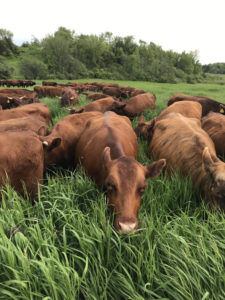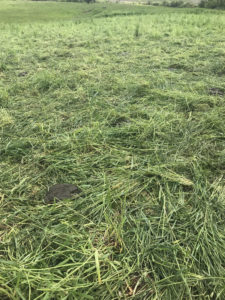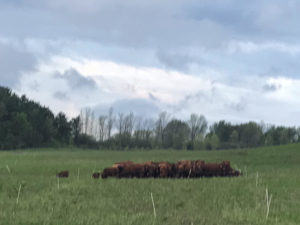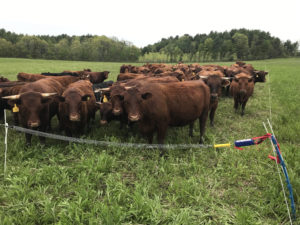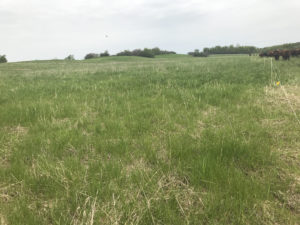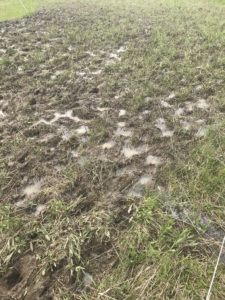Final report for FNE19-920
Project Information
What are ecological, effective and economical practices for regenerating heavily degraded grassland on clay soils in the humid Northeast?
Our study investigated how different stocking density of cattle may impact land regeneration by way of soil and pasture changes and farmer livelihood by comparing three grazing regimes, use of batt-latch technology, and eight different pasture renovation experiments on degraded grassland.
For grazing regimes, we compared one-day grazing treatments: 0-moves of 50,000, 3-moves of 140,000, and 10-moves of 500,000 pounds live weight per acre stocking densities on three 1.5 acre test plots respectively, with corresponding moves conducted via batt-latch automatic gate release with a trained cattle herd of 70 animal units. We recorded standard pasture soil sample analysis data, animal grazing hour observations, and labor hours for each treatment area. Additionally and separate from the treatment sites, we experimented with 1) subsoiling with a Yeomans plow at 14 inch depth to address deep compaction, 2) roller crimper to kill spotted knapweed and mulch plants in place, 3) no-till drilling of warm-season annual species and separately of cool-season annuals, 4) broadcast seeding of warm-season annuals ahead of LD, HD, UHD grazing, 5) brush hogging to control spotted knapweed seeding, 6) application of finished compost, 7) application of aged wood chips, and 8) bale grazing.
Due to previously unforeseen site conditions of excessive compaction and severely inhibited water infiltration, our grazing regime comparison failed to yield replicable results, and instead only further compacted what became a fully moisture saturated site during a 0.5 inch rainfall event on the first day of the 500,000 lbs/acre treatment. Combined with pervasive soil sampling errors, we were unable to provide successive grazing cycle data or quantitative soil results for the grazing stocking density portion of the study.
We did however determine that batt-latch technology in our study conditions saves graziers $1/grazing day/cell move. In other words, graziers who move animals daily can save more labor hour time and wages the more days of grazing (for example, through stockpiled forage through the fall and winter) and the more cell moves per day (for example, higher stocking density grazing with more cell moves per day) practiced. A $400 batt-latch pays for itself in 400 grazing days.
Of the eight additional treatment experiments, only bale grazing showed observable benefit over the duration of the project timeline. Within one year post-bale grazing treatment, we observed greater plant biodiversity, a dramatic decrease in spotted knapweed, the highest prevalence in red clover and the lowest penetrometer reading (lowest soil strength/lowest compaction) in the entire study field.
During and post-study project, we shared our results and learnings via consultations, on-farm demonstrations, and social media with farmers, researchers, service providers, students, and farm community members.
This project seeks to analyze the impact of three grazing management regimes (see methods: LD-MIRG, HD-MIRG, and UHD-MIRG) on pasture productivity, soil health and farmer livelihood in the context of revitalization efforts on highly degraded grassland. We will implement three 2-acre treatments on land that heretofore has been conventionally managed for intensive hay production. We want to test whether increasing the stocking density and number of herd moves per grazing day can increase the stocking rate (i.e. carrying capacity) of the pastureland while improving soil health. We also want to economically assess the impact of employing batt-latch technology to implement each MIRG regime. We hypothesize that the batt-latch technology will greatly improve the economic efficiency of an intensive grazing system requiring multiple herd moves per day by way of minimizing farmer time and increasing stocking rate. We predict that the highest stocking density and greatest number of moves per day will correlate with the largest improvements in pasture productivity and soil health. Success in the context of this project will entail determining strategies for an economically efficient means of regenerating highly degraded grassland.
Our project seeks to better understand how high-density, management-intensive rotational grazing (MIRG) strategies can regenerate degraded agricultural land while improving farmer livelihoods. In 2009 we began managing 143 acres of compacted, degraded soils on a former conventional dairy farm and have since anecdotally seen vast productivity improvements with our MIRG of cattle. As we begin managing an additional 375 acres of former dairy land, we have an opportunity to level-up our grazing practices and better understand MIRG’s capacity to regenerate degraded land. Our project proposes using solar powered timed automatic gate release (batt-latch technology) for high-density MIRG to allow more herd moves per day while requiring less farmer time.
Commodity milk has greatly declined as a viable farming business due to market volatility, production practices, and a degraded landscape resulting in a high rate of farm closures and land transfers now with a significant increase predicted. Despite this market failure, the Northeast is well suited to grass-based ruminant production (e.g. beef) and productive grassland strategies that enhance soil health and economic efficiencies may help bolster surviving dairy farms while offering an economically viable business for new and existing farmers. We believe this study could have positive widespread impacts on the Northeast and offer a piece of the puzzle in keeping much of the land in question in agriculture while also regenerating degraded soils and impaired ecosystems.
The rich agricultural legacy of dairy farming is evident throughout Vermont and the Northeast even as the dairy industry continues its roller coaster of milk prices and production costs with what looks like a grim future. In the last decade, Vermont has lost nearly 1/3 of its cow dairy farms (Heintz, 2018). While many discussions around the dairy crisis focus on economic drivers and impacts, there is another element to consider: land use. Acreage devoted to hay, haylage, feed corn, and corn silage constitutes approximately 30% of agricultural land in Vermont (USDA, 2012). However, as dairies in the region close, demand for local hay and corn products is declining (Heintz, 2018). Amid the hardship, there is opportunity to explore strategies to improve the ecological health and economic viability of land previously tied to the dairy industry in the Northeast.
Land that has a long history of continuous hay and/or corn production is often highly degraded. Compaction from tillage and haying equipment impairs ecosystem hydrologic and nutrient cycles, with significant consequences for soil health. It is commonly understood that soil erosion and nutrient runoff are byproducts of highly degraded pasture or cropland and that they contribute to water quality issues (Waters 1995). Such externalities are abundantly evident in the new land that we began managing on June 1, 2018. The land was all conventionally managed for hay and corn production for many years. Consequently, the soil and surrounding agroecosystem are in extremely poor condition.
This project aims to better understand how management-intensive rotational grazing (MIRG) strategies can regenerate degraded agricultural land and improve farmer livelihoods. MIRG prescribes high stocking density and frequent grazing herd moves. However, many variables have not been adequately studied and ecologically optimal stocking density and daily herd moves in the context of pastureland regeneration remain uncertain. Consequently, we are motivated to explore these issues and to examine the economic viability of MIRG strategies in the context of grass-fed beef production. While MIRG has the potential to ameliorate ecological degradation, it requires significant time investment from farmers, which brings into question the economic viability of the strategy. Batt-latch technology offers a time-saving solution, but the application and impacts of this technology have not been rigorously examined.
Given this twofold focus, our project has broad applicability within the Northeast. As we have outlined above, there is likely to be an increasing amount of farmland available much of which is likely to have highly degraded soils and impaired ecosystems. Exploring ways to keep this land in agriculture while also regenerating agroecosystems and contributing to farmers’ economic livelihoods will be highly relevant for farmers throughout the region. Determining optimal grazing strategies that increase the resilience of both soils and farmer livelihoods for climate change adaptation would be widely valuable to farmers throughout the region. Our clay soils are typical of Vermont’s Champlain Valley and many other lacustrine and riparian soils throughout the Northeast that are potentially highly productive but present management challenges in the era of climate change.
Throughout its 10 years, Bread & Butter Farm has practiced MIRG with beef cattle for agroecosystem regeneration on its 143 acres of land permanently conserved through the Vermont Land Trust - land we have seen soil, pasture, and surrounding ecosystem health flourish in correlation with our MIRG practices. We now manage a total of 600 acres of owned and leased land that was historically intensively hayed and cropped or continuously pastured; as a result, inherited soil health is poor and pasture productivity low. With our expanded lands, we want to seize the opportunity to supplement our anecdotal observations with data that clarifies and confirms the interaction between MIRG strategies and regeneration of degraded land.
Our 50-head herd of 100% grass-fed Devon cattle are mostly born and raised on the farm. All beef, grossing over $60,000 annually, is sold on-farm direct-to-consumer in our farm store and CSA. Total farm gross annual income exceeds $400,000 with vegetables, pork, beef, resale products, events, and education.
Corie Pierce, farm owner, and Brandon Bless, animal and land manager, are full-time farmers responsible for a team of 4 year-round farmers and educators, a seasonal staff of 25, and all farm management decisions. These two individuals represent 35 years of experience managing farm operations, 15 years of college-level teaching to aspiring farmers, and hold natural resources undergraduate and graduate degrees and professional certificates. This experience is supplemented by our connection to the ALC, our technical partner. Dr. Ernesto Mendez, director of the ALC, brings 20 years of experience conducting agroecological and agroforestry research with smallholder producers. This connection will be vital in conducting and analyzing soil sampling to assess the impacts of our treatments on soil health.
Fencing and water equipment (~$1000) supplied by farm. October 2018/19 soil testing supported by ALC funds.
Cooperators
- - Technical Advisor (Researcher)
Research
We conducted a three-treatment experiment to determine any variable soil and pasture health responses and economic analysis to different stocking densities and grazing period lengths. Our three treatments are outlined below.
Terminology:
Management-intensive grazing - prescribed pasture management that mimics wild ruminant herd patterns and grassland coevolution by using high stocking density, short grazing duration, and long grazing rest period to benefit both land and animal health and production (also labeled "mob grazing" or "intensive rotational grazing" or "adaptive grazing")
Stocking density - pounds of animal live weight per unit of land - often per 1 acre (or hectare) and calculated from grazing cells smaller or larger than 1 acre
Animal unit - equivalent to 1000 lb live weight cow, and 2.6% body weight of plant dry matter consumption per day
Stocking rate - number of animal units able to graze on a unit of land as a function of plant dry matter
Grazing duration - amount of time a herd grazes and ruminates within a cell excluding sleep hours
Grazing cell - the fenced area of a single herd move
Grazing cycle - the successive grazing of the same land/cell over the year
Rest period - the amount of time between grazing cycles
Batt-latch - solar powered pre-set time released electric fencing gate that automatically opens successive grazing cells
Study Site:
Treatments were conducted on three approximately 1.5-acre areas located on newly acquired land. The three test plots were selected to minimize differences in elevation, slope, and soil characteristics; sites correspond to areas where we were able to collect baseline soil data in October 2018. The common soil type is Vergennes clay. Treatment areas were delineated and recorded using GIS mapping software via smartphone apps. Additionally, we employed GPS geolocation ground-truthing to verify coordinates of the treatment sites. The analysis, comparison, and final assessment of soil health and economic efficiency impacts were done in collaboration with our technical partners. The cattle herd represented approximately 70 animal units or 70,000 pounds live weight.
Treatment One, Low Density MIRG (LD-MIRG):
This treatment served as a type of a control, representing a much more traditional and conservative form of MIRG. Stocking density was held to approximately 30,000 pounds of animal live weight per acre. The cattle had access to a single grazing cell as the full approximately 2-acres for a available forage determined period. This treatment requires no additional moves, and therefore does not require the use of batt-latches.
Treatment Two, High Density MIRG (HD-MIRG):
This treatment explored a higher stocking density, which corresponded to smaller grazing cell size and multiple moves per day. We used an approximate stocking density of 100,000 pounds of animal live weight per acre. To achieve this, cattle grazed on cells approximately 0.6 acres in size, and were move through three cells over the course of a grazing day with an estimated 6.5 hour grazing duration per cell. Moves were facilitated by the use of two batt-latches.
Treatment Three, Ultra High Density MIRG (UHD-MIRG):
This treatment applied an ultra high stocking density, the impacts of which have not been sufficiently explored in scientific research but in our experience have shown the most promising results. We used an approximate stocking density of 500,000 pounds of animal live weight per acre. This ultra high stocking density was achieved through the construction of many very small grazing cells and a very short grazing duration. Cattle were moved through 15 cells in a grazing day with an estimated 1.5 hour grazing duration per cell (approximately 4 hour grazing duration overnight). Moves were facilitated by the use of seven batt-latches (which will be recycled, so to speak, mid-day to keep equipment costs manageable during this stage of assessing efficacy of this technology).
Soil Sampling:
For each of the three treatment sites we already had a composite sample subject to the Cornell Assessment of Soil Health at the Cornell Soils Lab, and we have baseline, pre-grazing data on penetration resistance, and bulk density prior to beginning our MIRG regimes. In October of 2019, at the end of the grazing season for the treatment areas, we conducted successive rounds of soil sampling to assess change in soil health. This included penetration resistance, bulk density, biological assessment and a second round of analysis through the Cornell Soils Lab or another soil testing service. We were not able to conduct water infiltration tests.
Pasture Productivity:
All treatment area grazing cells in each grazing cycle were GIS delineated and photo-recorded for pre- and post-grazing, and grazing hours were recorded. We calculated the pre- and post-grazing dry matter in pounds per acre using animal grazing days per acre determined by herd residence time per grazing cell. We also conducted observations of pasture plant diversity in each treatment area.
Economic Analysis:
Farmer time was recorded for all work associated with moving the herds through the treatment sites. This included time to set up and manage treatment areas (e.g. fencing, batt-latches, water, minerals) before, during and after grazing days in each grazing cycle. The LD-MIRG treatment site was indicative of the cost of farmer time spent on management without the application of batt-latch technology; we could then extrapolate outward to approximate the amount of time spent moving herds without the batt-latches for HD and UHD regimes. This gave us a sense of both the time and cost savings associated with applying batt-latches in the HD-MIRG and UHD-MIRG treatments.
BATT-LATCH FOR LABOR SAVINGS
Results showed labor savings of $1/day per additional cell move assuming one cell move per day is performed manually by farmer. Batt-latches are worthwhile equipment for any farm practicing multiple grazing moves per day.
|
MEASUREMENT |
units |
MIRG TREATMENT |
||
|
LD |
HD |
UHD |
||
|
TIME TO FENCE 100 FEET |
minutes |
1.3 |
||
|
TREATMENT PADDOCK SIZE (acres) |
acres |
1.5 |
||
|
PADDOCK PERIMETER (feet) |
feet |
3300 |
||
|
TIME TO FENCE PADDOCK (minutes) |
minutes |
43 |
||
|
GRAZING CELL FRONT LINE LENGTH (feet) |
feet |
40 |
||
|
CELL SIZE (acres) |
acres |
1.5 |
0.5 |
0.14 |
|
NUMBER OF CELLS |
1 |
3 |
10 |
|
|
TIME TO DIVIDE ALL CELLS (minutes) |
minutes |
0.0 |
1.1 |
4.7 |
|
TIME TO SET UP BATT-LATCHES (minutes) |
minutes |
0 |
3 |
14 |
|
TOTAL TIME TO MOVE ANIMALS PER PADDOCK (minutes) |
minutes |
43 |
47 |
62 |
|
TRAVEL TIME TO PADDOCK (minutes) |
minutes |
3 |
||
|
TIME FOR MANUAL CELL MOVE (minutes) |
minutes |
1.5 |
||
|
TOTAL TIME TO MANAGE PADDOCK AND CELL MOVES WITHOUT BATT-LATCHES (minutes) |
minutes |
43.3125 |
53.3625 |
88.5375 |
|
PADDOCK TIME SAVED WITH BATT-LATCHES vs MANUAL MOVES |
minutes |
0 |
6 |
27 |
|
TIME SAVED PER CELL MOVE WITH BATT-LATCHES |
minutes |
3 |
||
|
HERDSPERSON $/HR |
$ |
20 |
||
|
ANNUAL LABOR SAVINGS PER ADDITIONAL CELL MOVE (230 day grazing season) |
hours |
11.5 |
||
|
ANNUAL LABOR SAVINGS PER ADDITIONAL CELL MOVE (230 day grazing season) |
$ |
230 |
||
|
COST FOR ONE BATT-LATCH |
$ |
400 |
||
|
TEN YEAR LABOR SAVNGS PER ADDITIONAL CELL MOVE (230 day grazing season) |
$ |
1900 |
||
SOIL DATA
Baseline and annual soil samples and lab testing was conducted by UVM students engaged in agroecology coursework. Unfortunately, due to the nature of student learning and inconsistencies and errors that are part of any learning process, we are unable to rely on the soil data. None of the soil data are considered reliable due to frequent and undiagnosed field sampling errors as well as lab test errors.
GRAZING DENSITIES FOR LAND REGENERATION?
We executed our three stocking density grazing trials beginning in May 2019. We measured each stocking density treatment area as follows:
|
MIRG TREATMENT |
GRAZING CYCLE |
ANIMAL UNITS |
LIVE WEIGHT PER ACRE |
CELL SIZE (acres) |
STOCKING DENSITY |
CELL RESIDENT TIME (hours) |
ANIMAL GRAZING HOURS / ACRE |
SPECIES COUNT |
|
LD |
1 |
70 |
70000 |
1.5 |
50000 |
5 |
233 |
5 |
|
HD |
1 |
70 |
70000 |
0.5 |
140000 |
2 |
280 |
6 |
|
UHD |
1 |
70 |
70000 |
0.14 |
500000 |
0.5 |
250 |
6 |
As noted in our methods, the three 1.5-acre test plots totaling 4.5-acres together, were selected to minimize differences in elevation, slope, and soil characteristics. In other words, test plots were located in the flattest area of the field. For the study site field, the flattest area coincidentally is a valley catchment for approximately 37 acres of hillside with a 7% average slope.
During the first UHD grazing cycle in overnight grazing cells in May, 2019 the site experienced 0.5 inches of rainfall during a 9 hour period from approximately sunset to sunrise with a peak rainfall of 0.1 inches/hour occurring at midnight. As is typical for the month of May in the Champlain Valley of Vermont, soils were already moist from spring rainfall events.
Importantly, later in the summer of 2019 (after our initial grazing treatments) we performed penetrometer tests and test pit examinations for the 37 acre hillside. We found that the entirety of the field has 3 to 9 inches of topsoil with functional rooting and moisture percolation limited to this depth by a ubiquitous monolithic compacted hardpan that tested in excess of 300 psi. We theorize that this hardpan is a combination of geologic glacial till and historic intensive heavy equipment and tillage management compaction factors. We found compaction in all areas except hedgerows where deep rooted trees grew and no mechanization occurred for several decades. Incidentally, we observed the hedgerows universally had rockier soils, deeper top soil (14 inches), minimal/no spotted knapweed, and the most productive grassland in the entire field even under dappled tree shade.
If considering the study site in isolation from the 37 acre catchment lands above, the overnight 0.5 inches of rainfall on already moist spring soil would have made for merely moister soils - a common characteristic of Spring grazing in Vermont. Because the study site also serves as the valley catchment for 37 acres above with an average 7% slope and minimally pervious hardpan at 3-9 inches depth, the study site received a small flood of water over a 9 hour period.
The quantity of moisture and the high soil saturation resulted in UHD grazing creating extremely compacted and degraded soil with mud present throughout the overnight grazing cell. While we expect LD and HD treatments may have created similar but less extreme impacts under the same conditions, we did not attempt to find out.
For the duration of the project, we noticed almost no revegetation on the UHD site, including very poor germination and growth from our attempt to mechanically drill summer annual seeds into the UHD study site soil during the summer of 2019. T
he LD and HD grazed areas showed no significant changes during the project duration. An obvious but incomplete explanation for insignificant changes from LD ad HD grazing treatments is the heavily damaged and compacted UHD strip immediately uphill from the HD and LD treatment areas. The compacted UHD treatment soils would have been unable to infiltrate precipitation runoff and further contributed to disproportionate moisture and water logging of the LD and HD treatment areas from the hillside above and consequently inhibited plant productivity.
A more interesting and possibly more useful theory is that the entirety of the study site we consider to be stuck in an "alternative stable state". We observe extremely compacted and shallow soils of the study site and the associated pervasiveness of spotted knapweed (and reed canary grass) developed over decades of homogenous land use practices of intensive haying with heavy equipment, including the most intensive management in the preceding 6 years of 30-day green chop practices with very little fertility returned to the land. Collectively the management impacts of over harvesting plant biomass, no/minimal return of fertility, and severe compaction from heavy equipment on depleted clay soils have left the study site with only two dominant plant species. Reed canary grass (Phalaris arundinacea) represents nearly a monoculture in water logged areas or valley land shapes, while spotted knapweed (Centaurea stoebe) is the dominant species on all drier areas and ridge land shapes (excluding hedgerows) that we estimate to comprise at least 50% of the field plant population and upwards of 70% of the population on the driest soils. Spotted knapweed is a deep taprooted biennial that can produce seed within 1 month of being mowed or grazed even up to three times annually because of its low to the ground rosette morphology. The taproot can source otherwise hard to find water as well as nutrients. While rich in protein, the plant is lowly palatable making for challenging feed. Spotted knapweed also produces allelopathic chemical to inhibit nearby plant growth. There is no single management control for this species. A literature review shows that managers must use a suite of practices that may include tillage, chemical, cutting, grazing, and biological introduction controls.
While not included in this study's experimental design, we did attempt to address the alternative stable state and spotted knapweed dominance of the field with several perturbations that we will summarize here. To perturb the stable state we deployed several practices both in isolation and in combination throughout the study site field. These practices included: 1) subsoiling with a Yeomans plow at 14 inch depth to address deep compaction, 2) roller crimper to kill spotted knapweed and mulch in place, 3) no-till drilling of summer annual species and separately of cool season annuals, 4) broadcast seeding of summer annuals ahead of LD, HD, UHD grazing, 5) brush hogging to control spotted knapweed seeding, 6) application of finished compost, 7) application of aged wood chips, 8) bale grazing. A brief review of the more promising practices, their specific application, and our observation results follow.
SUBSOILING FOR DECOMPACTION
In the summer of 2020, we used a six foot wide 3-shank Yeomans plow set at 14 inch depth to subsoil 4 acres of the study field on a Keyline pattern. The subsoiling action is intended to decompact the site soil through mechanically ripping into the hardpan, lifting the soil slightly and then dropping it to shatter the compacted layers. This is the most aggressive and perhaps the most expensive intervention we attempted. We estimate with our site conditions and equipment that subsoiling to 14 inches to require 0.5 hours per acre, plus 1.75 gallons of tractor fuel per acre, for a total estimated labor+equipment+fuel cost of $68/acre.
While it is too soon to understand the full impacts of the subsoiling practice, we did measure subsoiled vs non-subsoiled soil strength with a penetrometer throughout the 2020 season and found no difference in penetrometer readings except immediately adjacent to the subsoil shank rip line where there was a modest decrease in soil strength. The lack of immediately observable or measurable decompaction may also have been from the heavily worn condition of the Yeomans plow shank attachments. We installed all new shank hardware and will attempt another trial in 2021. We hypothesize noticeably reduced soil strength near the rip lines in the spring of 2021 due to freeze-thaw action of winter water infiltration in the 14 inch deep rip lines.
ROLLER CRIMPER FOR SPOTTED KNAPWEED CONTROL
We used a 12 foot, sand-filled riller crimper to attempt to both kill and mulch in place the spotted knapweed at pre-flower stage. In (nearly) pure stands of spotted knapweed, the roller crimper had almost no effect. The implement successfully crimped the knapweed but the plant merely returned to its upright position with stem crimped and continued to grow - even after multiple multi-directional passes with the roller crimper. In stands of knapweed with mixed tall grasses, the knapweed "lodged" with the grasses and the roller crimper successfully layed down or mulched the stand of plants. While the grasses were killed by the roller crimper, unfortunately the knapweed was not and continued to grow from a prostrate position and actually expedited flowering and seed production. Though promising in theory, we do not intend to use a roller crimper again for this control practice because of knapweed's low-to-the-ground rosette and thick woody stem that resist crimping.
NO-TILL DRILL & BROADCAST OF ANNUALS FOR SPOTTED KNAPWEED CONTROL
In summer 2019 we used a Haybuster 10 foot no-till drill to plant 2 acres to a cowpea, sorghum-sudans, pearl millet, radish, forage brassica and sunflower summer annual species mix (King's Agriseed Ray's Crazy Summer Mix) at 60 lbs/acre, and separately in spring 2020 we drilled into 2 acres a 5-seed cool season annual mix of oat, wheat, peas, winter rye, and hairy vetch at 120 lbs/acre. We also attempted in summer 2019 to hoof-seed on 0.5 acres the same summer annual species mix by broadcasting the seed ahead of our HD and UHD grazing practices. None of the summer annual seedings were successful. This could have been related to the unusually hot and dry summer we experienced. We had similarly poor luck with the cool season mix as the spring of 2020 was unusually hot and dry as well. However, the hairy vetch planted in spring 2020 did germinate and establish well in the warm and moist fall of 2020. Hairy vetch proved to be the only species we seeded that competed with knapweed. We are unlikely to attempt any no-till seeding practices in knapweed dominant sites due to the low success rate and the high cost of seed.
BRUSH HOGGING FOR SPOTTED KNAPWEED CONTROL
One-time brush hogging to inhibit knapweed seeding proved an expensive ($16/acre) and minimally successful practice with most of the knapweed continuing to seed within 30 days of brush hogging. To improve the effectiveness of this practice, multiple (monthly) mowings is likely required.
BALE GRAZING FOR SINGLE-PRACTICE REGENERATION
Bale grazing in winter 2019 and 2020 proved to be the most effective practice across every category of site regeneration even without any other associated management or practice combination. Bale grazing involves either placing hay bales or rolling/spreading out hay bales for animals to eat over winter or otherwise frozen/very dry soil conditions. The frozen/hard soil reduces or eliminates compaction from the animals. The bale locations determine where animals will deposit higher quantities of manure and urine. The inevitable residue of plant matter from the bales post-bale grazing is the most important contribution from this practice. Within a year, the bale ring residue site had a greater diversity and productivity of palatable pasture species (dominated by red clover) and a lower penetrometer reading (or lower soil strength - i.e. decompaction) than anywhere else in the study field. Plus bale grazing is a financial benefit if winter feeding is going to occur anyways. We have made plans to expand our use of bale grazing as a site regeneration practice.
Our study sought to determine how grazing stocking density affects pasture productivity and farmer livelihood by comparing three grazing regimes and the use of batt-latch technology on degraded grassland. Our results diverged dramatically from our hypothesis and prior 10-years of direct experience that higher stocking density correlates strongly with enhanced pasture productivity and soil health outcomes. Instead, our results for the study site showed strong negative correlation with stocking density. Clearly there were unique circumstances for our study and site that delivered these results. There is a caution in our study for appropriate site due diligence before implementing new practices, such as better soil and plant community observations ahead of direct management. This project supports adaptive grazing practices that rely on knowledgable and experienced graziers making real-time management decisions such as toggling stocking density based on hyper-site specific conditions. We will of course continue to practice adaptive grazing as it has been profoundly beneficial to the rest of our grazing land for the past 10 years of our management.
Our hypothesis that batt-latch technology is a worthwhile investment in farmer livelihood was confirmed. Our data show that batt-latches could be standard equipment for any profitable grazier.
While we learned and shared with our agricultural community a great deal over the course of our project including spotted knapweed management controls, efficient use of batt-latches, and site-specific adaptive grazing strategies, the fundamental design of our study was completely eroded by unforeseen soil conditions, and frequent soil sampling errors. However, some of the mistakes and errors in this project led us to devote more time, research, and experimentation in other alternative strategies for grassland regeneration, most of which have been summarized in this report. Bale grazing has proven to be by far the most promising regenerative practice to pursue in our context.
Education & Outreach Activities and Participation Summary
Participation Summary:
Spotted Knapweed consultations - we have informally begun consulting with other local farmers and service providers on spotted knapweed management, biology and uses with unique experiences to share from all of the practices we deployed including grazing.
We have held several on-farm demonstrations and tours with farmers, service providers, and students to share what we've learned through this study and to show the practices and techniques we have developed to address site conditions and enhance plant productivity. These on-site educational experiences have included walking tours, workshops (demonstrating MIRG and batt-latches), and equipment demonstrations (roller crimper, Yeomans plow, batt-latches).
We have posted regularly on the Regrarians Workplace forum both sharing our project study experiences and learnings, and also asking question of and learning from the Regrarians online community of farmers and practitioners worldwide.
We have shared with our local community updates on our study project through our CSA and farm-wide newsletters and our social media accounts. You can find a sample article here: A story about haying at Bread & Butter Farm
Learning Outcomes
Our challenge with study site location, weather and site conditions, pervasive compaction, and spotted knapweed management helped inform and educate local farmers, and UVM students. Obviously, we all learned more about site-specific adaptive grazing management and how to better understand heavily degraded land and the use of animal management practices. Notably, farmers and students gained much more KASA in unintended areas, such as, spotted knapweed biology and indicator characteristics, including bovine grazing management and spotted knapweed nutrition. We learned a great deal about the use of bale grazing practice to immediately, directly and powerfully address spotted knapweed through animal management. Additionally, farmers and students gained KASA from our use of equipment such as no-till drill for summer annuals planting to diversify and decompact site soil, Yeomans plow for Keyline subsoiling through site hardpan, hydro-push vertical beater compost spreader for both finished compost and aged wood chip application, and our novel use of a roller crimper and a chain drag harrow to address the spotted knapweed proliferation. In summary, we collectively learned that bale grazing was the single most effective and efficient practice to address within one year 1) compaction as measured by penetrometer, and 2) plant productivity and diversity while inhibiting spotted knapweed proliferation.
Project Outcomes
The first and foremost improvement in our management is enhancing our time and skills in better understanding the needs of heavily degraded farmland. This is both obvious, invaluable, and often overlooked because tillage and input applications are the norm in "correcting" damaged land.
The most effective outcome and improvement to our management is the use of bale grazing in winter. We experienced the simplicity and seemingly unmatched power of bale grazing in transforming degraded farmland in very short time. Briefly, if you have degraded land, feed hay, and can access frozen and/or very dry soils at certain time of year bale grazing is a primary practice for profitably restoring water and nutrient cycling.
The use of batt-latches is very helpful, but does require some minimal initial time investment in training animal herds and farmers on how to best work with these automatic gates. The use of this technology now allows us to conduct multiple herd moves per day while only requiring once per day farmer contact with the herd.
While our study design was appropriate, our due diligence in better understanding the study site conditions was lacking to the point of fundamentally undermining the project's intent and focus. We were challenged by the severe state of degradation exhibited by the study site. We were also challenged by frequent soil sampling and lab test errors. If we were to rework this project, we would be less interested in how to better tailor a project for adaptive grazing management on heavily degraded land. Instead we would develop a project focused on bale grazing as a base control for land regeneration and specifically to address spotted knapweed management. We believe spotted knapweed will only become a greater challenge in the Northeast until alternatively practices such as bale grazing are deployed to address the proliferation of this species on degraded soils. A bale grazing project could explore combination practices with bale grazing such as the use of subsoiling, seeding, bale unrolling vs placed bale grazing, or the use of a power harrow or other equipment for tillage ahead of bale grazing and incorporation of residue post bale grazing. Another useful component of this bale grazing project would be a comparison of unrolled bale residue without any grazing practice. A 3-year timeline for this project is recommended to more fully understand the practice's impact on a site.
